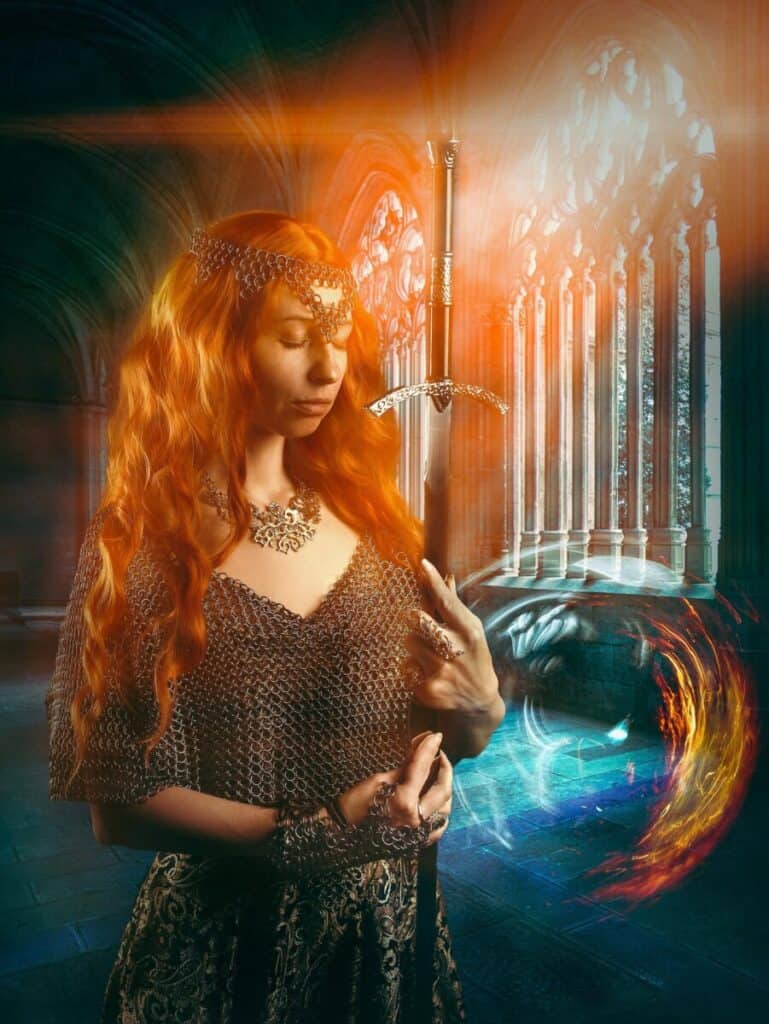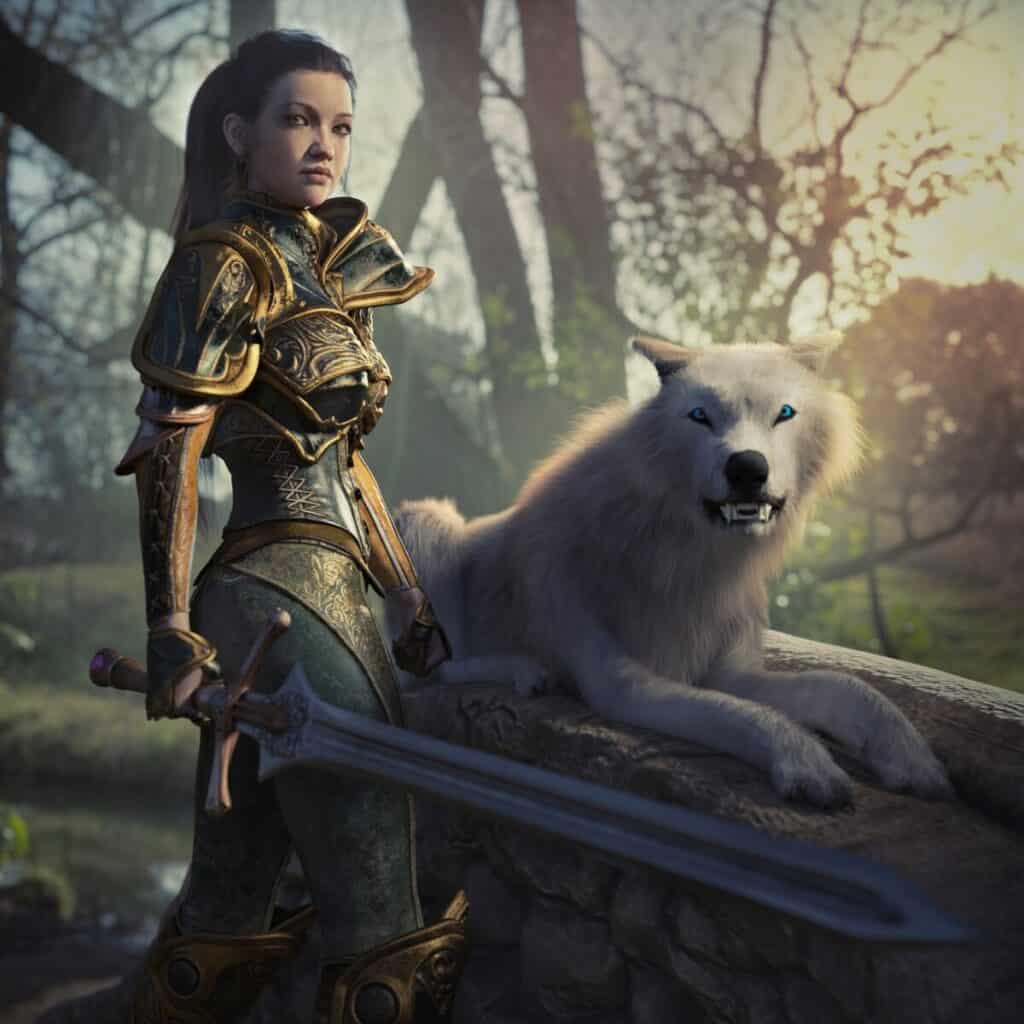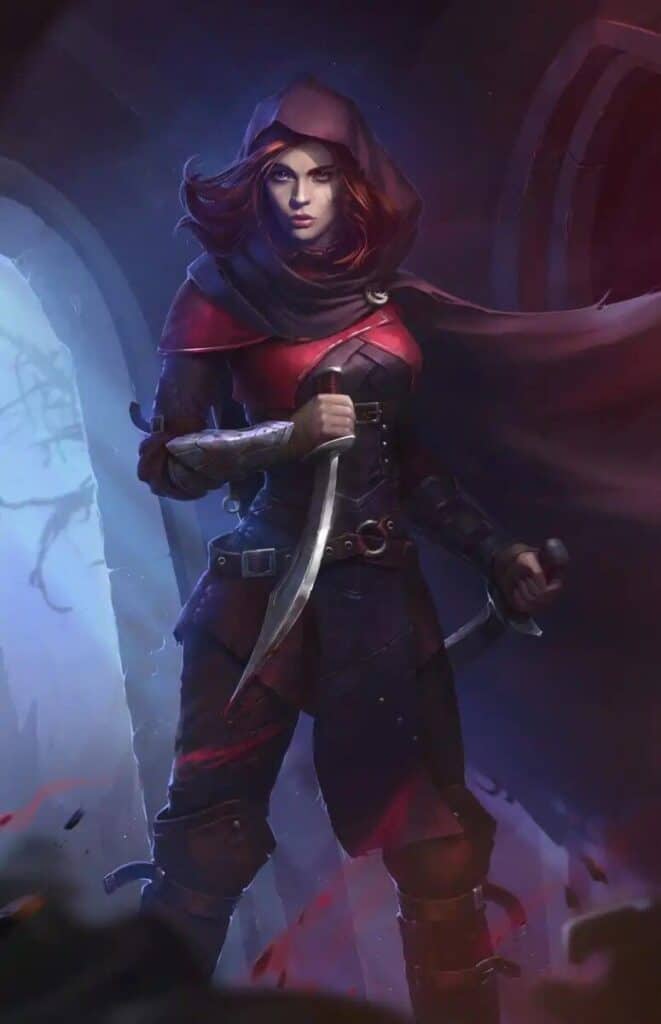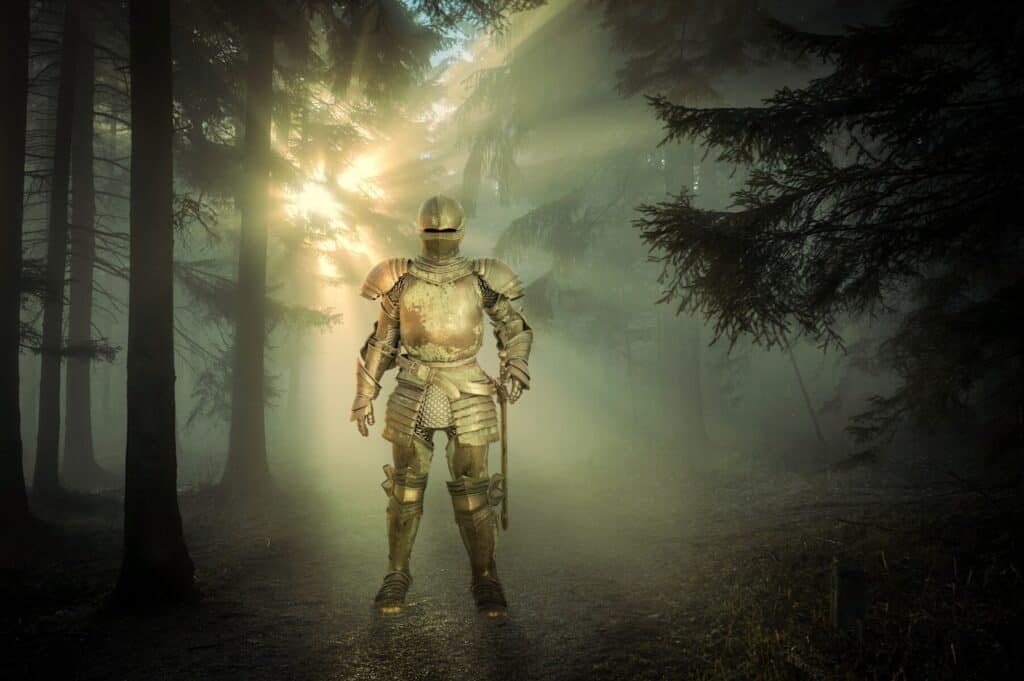There’s no getting around a common truth of many tabletop RPGs – spellcasters are harder characters to build, manage, and optimize than non-spellcasters. Despite a much more streamlined set of rules compared to its earlier versions, 5th edition Dungeons & Dragons is no exception, adding an entire extra page of information to any spellcaster’s character sheet.
That said, while magic in 5E D&D can be a lot to keep track of, magic is also undeniably fun. There are tons of different spells at your disposal, ranging from the straightforward damage of a fireball to the reality-warping capabilities of a wish. In the hands of an experienced and/or creative player, this versatility can easily give your party the advantage in many situations.
Fortunately, you don’t have to start in the deep end of spellcasting via a full caster like the bard, cleric, druid, sorcerer, or wizard to explore the potential of magic in D&D. 5E offers several classes and archetypes that provide half caster and third caster spellcasting options that are designed to supplement your other class features rather than hog the entire spotlight.
Half Casters
Half Casters are the most common type of partial caster in D&D 5th Edition, and in most other editions, as well. They are often a great blend of marital prowess and underrated magical abilities.
What Are Half Casters?
A half caster is a class or archetype that receives spellcasting spell slots at half the speed of a full caster of the same level, usually rounded up. This caps your highest level spell slots at 5th level instead of 9th, and is associated with artificers, rangers, and paladins in 5E.
Fun fact: I have to say it’s usually rounded up because rangers and paladins don’t receive their first spell slots until 2nd level. The artificer, having been designed much later in 5E than any of the other base classes, receives spells at 1st level to fully align with this rule of thumb.
To see how many spell slots a 5E DnD half caster receives at each level, you can refer to the chart below.
| Level | 1 | 2 | 3 | 4 | 5 |
|---|---|---|---|---|---|
| 1st | 2* | – | – | – | – |
| 2nd | 2 | – | – | – | – |
| 3rd | 3 | – | – | – | – |
| 4th | 3 | – | – | – | – |
| 5th | 4 | 2 | – | – | – |
| 6th | 4 | 2 | – | – | – |
| 7th | 4 | 3 | – | – | – |
| 8th | 4 | 3 | – | – | – |
| 9th | 4 | 3 | 2 | – | – |
| 10th | 4 | 3 | 2 | – | – |
| 11th | 4 | 3 | 3 | – | – |
| 12th | 4 | 3 | 3 | – | – |
| 13th | 4 | 3 | 3 | 1 | – |
| 14th | 4 | 3 | 3 | 1 | – |
| 15th | 4 | 3 | 3 | 2 | – |
| 16th | 4 | 3 | 3 | 2 | – |
| 17th | 4 | 3 | 3 | 3 | 1 |
| 18th | 4 | 3 | 3 | 3 | 1 |
| 19th | 4 | 3 | 3 | 3 | 2 |
| 20th | 4 | 3 | 3 | 3 | 2 |
Why Play a 1/2 Caster?
Half casters embody the idea that “less is more” when it comes to spellcasting. Newer players playing a half caster don’t have to keep track of nearly as many spell options as the full casters in a party, making it easier to learn 5E’s magic system at your own pace and allowing you to put more energy into immersing yourself in your DM’s campaign.
Magic is also designed to play a supplemental role for your character rather than be your entire identity as a half caster. You can easily be a competent melee or ranged weapon combatant compared to most wizards and sorcerers, have a larger health pool than many spellcasters, and be a useful support spellcaster for yourself or your party when the need arises!
So which half caster is right for you? Let’s take a brief look at each class to see what they bring to the table.
Artificer
Artificer Oversimplified: A half caster who is an extremely flexible jack of all trades and can change their spells and magic items to become a variety of supplemental specialists with a day’s preparation.

Artificers typically require the most player ambition of half caster classes in 5E, as they have the most to manage. In addition to receiving spells a level earlier than rangers or paladins, artificers also gain access to infusions at 2nd level, which are used to make magic items for themselves and/or members of the party that can bolster strengths or shore up weaknesses.
As half casters, this concept of party support is all over their spell list. They receive useful restorative magic in the form of Cure Wounds, Lesser Restoration, and Protection from Poison, potent buff spells like Fly, Haste, and See Invisibility, battlefield control via Faerie Fire, Grease, and Web, and also gain access to ritual casting for free with a solid suite of ritual spells.
While certain artificer archetypes lend themselves to specific types of support spells (for example, the Alchemist encourages you to use healing magic), your party composition and role in a typical fight is more likely to determine which type(s) of support spells are most useful to you and/or your allies.
Your role as an artificer can also be considerably more fluid than with other classes, as artificers are able to be formidable melee and ranged combatants, particularly if you go the route of the Armorer or the Battle Smith.
You might be buffing a tank on the front line while disrupting the distant enemy wizard’s magic one fight, then gumming up the movement of a group of bandits so you can snipe them the next. If you have forewarning and are able to prepare for a conflict 1 long rest in advance, it’s also easy to pivot your infusions and spells to become a specific combat specialist for the day.
Between this battle prowess and their support spell flexibility, artificers are extremely attractive for players seeking a jack of all trades build, those who want the array of options a full caster has without tying them all to spells, those who like attuning to lots of magic items, or those who want to explore the closest thing 5E has to magic item crafting.
It’s also a great class for players who like building lots of characters, as you can easily reshape your build lots of different ways without disrupting the campaign by introducing an entirely new character.
Paladin

Paladin Oversimplified: Half casters who Smite, SMITE, and MORE SMITE their enemies. And use Auras to passively buff nearby party members while smiting.
Paladins are half casters who are usually found on the front lines of combat, tanking melee attacks from the first enemies to engage and/or the big bad while returning them with interest. They aren’t able to put out the sheer number of attacks a fighter can, but the attacks they do hit with can be much more devastating in exchange.
This higher damage output is tied to the paladin’s ability to smite their enemies. These special attacks are harnessed either through specific spells like Thunderous Smite or Blinding Smite, which can change the type of damage you do and/or have an extra effect, or simply by sacrificing a spell slot to their Divine Smite class feature for a higher amount of radiant damage.
Despite this being the most common use for a paladin’s limited casting capabilities, they also have access to other helpful spells if you can spare the spell slots.
At earlier levels, detection spells like Detect Magic, Detect Poison and Disease, and Detect Evil and Good are ideal for taking point, identifying when to use Lay on Hands to clear a condition, or expanding your Divine Sense to gain information about your surroundings and potentially hidden foes.
Once you get access to higher level magic, spells like Aura of Life, Aura of Purity, and Magic Circle supplement the paladin’s Aura of Protection and Aura of Courage, allowing you to protect and bolster your nearby allies while still devoting your full attention to the battle in front of you.
That said, if you want to play a paladin, it’s generally because you want to devote most or all of your spells to smite, SMITE, and MORE SMITE.
While you have access to some useful utility and healing magic, any of it you dedicate to the party is generally going to be a bonus rather than a consistent feature unless you know there isn’t going to be much battle on a given day.
Ranger
Ranger Oversimplified: Scouts who can literally question the environment about a creature’s whereabouts, stealthily lead a group of adventurers to any location, then fill their enemies full of arrows.

Rangers, like the class name suggests, are half casters who tend to thrive in ranged combat roles due to the support of their spells, but can be plenty dangerous when built as melee fighters too.
Skilled trackers who are equipped to survive in a variety of environments, a ranger’s magic also complements their lifestyle by having an overarching nature theme that expresses itself a few different ways.
Hunter’s Mark and Pass Without Trace tend to be staple spells, as the former lets you easily mark targets up to 90 feet away for easy tracking and an extra d6 of damage each time you hit with any weapon attack, and the latter gives your whole party a +10 bonus to Stealth checks.
Pass Without Trace also enables you to travel without leaving footprints or other signs of your passage, which can be surprisingly useful without you even realizing it. Your DM will know though, especially if it ruins a prospective ambush.
If you want to further supplement your ranged damage, Hail of Thorns can add an area of effect to the next ranged attack that hits an opponent, letting you effectively damage weaker groups of enemies. As you level, Lightning Arrow performs a lesser impression of Lightning Bolt that is still surprisingly effective, and Swift Quiver lets you attack an extra 2 times each turn.
For those who prefer to use their limited spell slots for battlefield control, Spike Growth and Silence make a nasty combination for shutting down enemy spellcasters, which can be made even more treacherous at later levels with the addition of Plant Growth and Grasping Vine.
Looking for a specialization outside of combat? Nondetection is great for scouts who don’t want to be found, and you can work in concert with your animal companion or other friendly beasts to survey an area via Beast Sense and Speak with Animals. Speak with Plants can also yield some surprisingly helpful information from plants who “witnessed” the last day’s events.
Rangers also have some useful detection and healing spells, but other classes tend to perform these roles more effectively. Feel free to prepare a spell or two from these categories if you like, but most rangers are better served leaning into combat or scouting spells with their limited spell slots as they mesh most effectively with their tracking and combat class features.
Third Casters
What Are Third Casters?
A third caster is a class or archetype that receives spellcasting spell slots at 1/3 the speed of a full caster at the same level, with partial levels usually rounded up. This caps your highest level spell slots at 4th level instead of 9th, and is associated with the Arcane Trickster rogue archetype and Eldritch Knight fighter archetype in 5E.
As with half casters, I have to say it’s usually rounded up because Arcane Tricksters and Eldritch Knights don’t receive their first spell slots until 3rd level. Oddly, no other third casters were designed beyond these two class archetypes, suggesting 5E’s game designers weren’t fully satisfied with their execution in the Player’s Handbook.
Why Play a 1/3 Caster?
Spellswords have been a popular character concept for decades in D&D, and the Eldritch Knight and Arcane Trickster both serve as early nods to the multitude of fantasy characters from 3rd and 4th edition D&D that embody sword and sorcery as a seamless style of combat.
In 5E, these two class archetypes have very few spell slots to manage (as seen in the table below), serving as the least involved introduction to casting spells in the entire system. Each only allows you to take the bulk of your spells from 2 specific schools of magic (Illusion and Enchantment for the Arcane Trickster, Abjuration and Evocation for the Eldritch Knight).
This dramatically restricts your available spell options, despite both archetypes drawing from the wizard spell list, even when browsing through multiple books. Leveling up is simplified in turn, encouraging you to place more focus on the fighter’s battle prowess or the rogue’s stealth and sleight of hand than you otherwise might.
| Level | 1 | 2 | 3 | 4 |
|---|---|---|---|---|
| 3rd | 2 | – | – | – |
| 4th | 3 | – | – | – |
| 5th | 3 | – | – | – |
| 6th | 3 | – | – | – |
| 7th | 4 | 2 | – | – |
| 8th | 4 | 2 | – | – |
| 9th | 4 | 2 | – | – |
| 10th | 4 | 3 | – | – |
| 11th | 4 | 3 | – | – |
| 12th | 4 | 3 | – | – |
| 13th | 4 | 3 | 2 | – |
| 14th | 4 | 3 | 2 | – |
| 15th | 4 | 3 | 2 | – |
| 16th | 4 | 3 | 3 | – |
| 17th | 4 | 3 | 3 | – |
| 18th | 4 | 3 | 3 | – |
| 19th | 4 | 3 | 3 | 1 |
| 20th | 4 | 3 | 3 | 1 |
Arcane Trickster
Arcane Trickster Oversimplified: Why get up close to threatening obstacles when I can use Mage Hand to distract enemies, pick pockets, and disarm traps from a distance? Illusion and Enchantment spells will make escape a simple matter.

Admittedly, there’s a bit more nuance to the Arcane Trickster beyond Mage Hand, but as it dominates half of this archetype’s abilities, it goes without saying that it is the single most important spell you’ll take when building this unique rogue. Fortunately, it’s also a cantrip, so you’ll be able to cast it limitlessly.
From early levels, your Mage Hand can be made invisible and used to stow or retrieve objects worn or carried by other creatures, even if they’re in containers. it can manipulate thieves’ tools to pick locks and disarm traps up to 30 feet away, and can even be controlled as a bonus action during combat, making it great for pinching potions or dumping out alchemist’s fire.
While you can perform these actions undetected with a successful Sleight of Hand check, spells that partially take opposing perception checks away from the DM, such as Fog Cloud or Invisibility, can either make it much harder for the attempt to be detected or easier for you to get away without being identified if your attempt gets noticed.
These spells are also quite useful for setting up a Sneak Attack or Magical Ambush, as it will usually make it far easier to hide and gain advantage on an attack for massive damage or successfully hit an enemy with a spell you really need them to fail their save on.
Stealth spells aren’t the only useful ones for rogues, however. Spells that grant extra mobility, such as Levitate, Spider Climb, and Fly are all incredibly useful for getting to those hard to reach treasures, Knock will disable a surprising number of locks in seconds, Locate Object can cover for a failed Investigation check, and Rope Trick or Misty Step can set up a fast getaway.
The catch? None of these 7 spells are from the Illusion or Enchantment schools of magic (and neither is Fog Cloud). You only get to stray from these two schools of magic once at 3rd, 8th, 14th, and 20th level, so you’ll have to balance these four precious spell selections with the magical gear you have or think you can acquire down the road.
While many players are likely to find these restrictions frustrating or annoying, scrolls can easily get around this limitation, meaning enough gold (read: successful heists) is fully capable of making this problem go away.
Fortunately, while utility spells usually need this workaround to be readily accessible to an Arcane Trickster, combat spells are a little more accommodating under this archetype’s spell restrictions.
Spells that are capable of granting advantage on attacks, such as Shadow Blade, or spells that make you harder to hit, like Blur or Mirror Image, can dramatically improve your odds of winning many fights. You can also easily replace Shadow Blade at level 13 if needed, as that’s when you gain access to Versatile Trickster and its ability to grant advantage on attacks as a bonus action.
While many great spells have been covered here, the key to playing a good Arcane Trickster is creativity. There are an absolute ton of spells on the wizard spell list that can be useful to an enterprising rogue. Sure, your daily spell slots being limited mostly to enchantment and illusion spells isn’t ideal, but these schools of magic can do a lot of heavy lifting when given the chance.
Check Out Our Full Arcane Trickster Class Guide!
Eldritch Knight

Eldritch Knight Oversimplified: A Pact of the Blade Warlock who can summon weapons more quickly, cast spells and attack in the same turn, and is able to wear heavy armor.
Eldritch Knight is aptly named, as its Weapon Bond ability is very reminiscent of a warlock’s pact weapon. Your weapons of choice are never more than a bonus action away and you can’t be disarmed of them, ensuring you’re always ready for a close-quarters brawl or to take aim at a distant enemy once you’re in position.
Factor in that abjuration and evocation magic favor direct defense and offense and you’re going to be hell on wheels in most fights. Absorb Elements and Shield are great for mitigating damage, Burning Hands and Tasha’s Caustic Brew can put the hurt on groups of enemies, and Magic Missile is perfect for forcing through those last crucial points of damage.
Not all evocations are created equal when it comes to this class archetype, however. When choosing attack spells, prioritize those that require saving throws rather than attack rolls, as they tend to work best with the intended attack pattern of an Eldritch Knight.
This pattern is:
- Cast a damaging cantrip
- Make a weapon attack as a bonus action via War Magic, imposing disadvantage on the next spell save the enemy you hit makes from you
- Cast a spell that requires a saving throw next turn to improve your odds of dealing massive damage
If you think you’ll have the ability to hit multiple enemies with an area of effect like Fireball or Lightning Bolt, you can also choose to hit multiple enemies with attacks in place of the cantrip + bonus action attack. Either way, you get access to damage output that can easily be adapted to several different damage types and battlefields as a fight demands.
There are 3 tradeoffs to this battle prowess. First, you won’t have much access to utility magic, as you’ll only have access to spells outside abjuration and evocation at 3rd, 8th, 14th, and 20th level.
Spells that grant extra mobility, like Spider Climb or Fly are often useful for melee fighters, Blur and Hold Person can defeat a lot of attacks, and See Invisibility can simplify potentially obnoxious battles against invisible enemies. Your choices here aren’t quite as important as an Arcane Trickster’s, but you should still take time to truly consider what you need.
Second, the War Caster feat is all but mandatory, especially if you want to use a shield. Not having to worry about keeping a hand free to cast your spells makes a night and day difference for most melee-focused Eldritch Knights, and being able to cast Toll the Dead or Fire Bolt as your opportunity attack will almost always outdo any weapon you’re holding when they hit.
If you’re leaning into ranged combat or are using a two-handed melee weapon, War Caster isn’t as mission critical, but is often very useful for dealing with enemies who are determined to get in your face or if you elect to take spells that require concentration.
Finally, utilizing spells to do damage instead of weapon attacks removes your Strength or Dexterity bonus from the damage you deal. While this isn’t really a big deal when looking at the damage out put of a well placed Fireball or Burning Hands, this can become a real concern as you gain Extra Attacks.
1d8 or 1d10 + 5 per hit just isn’t going to compare well to 1d8, 1d10, or even 1d12 when averaged. Even if your Strength/Dexterity is only hovering around 16, the math still isn’t favorable. War Magic is intended to bridge that gap by giving you an extra attack when using cantrips, but you don’t receive that until 7th level, which can be an eternity in some campaigns.
None of these drawbacks are deal breakers for the Eldritch Knight, but they do raise compelling arguments for why a Bladesinger wizard might be a better fit for the Eldritch Knight’s style of gameplay.
Check Out Our Full Eldritch Knight Class Guide!
Partial Casters and Multiclassing
When the topic of multiclassing spellcasting classes comes up, half casters and third casters are either extremely easy to figure out or present some of the most complicated rules in all of 5th edition D&D.
First, the easy rules:
If you multiclass but have the Spellcasting feature from only one class, you follow the rules as described in that class.
Player’s Handbook, p.164
No complicated nonsense involving how many spells you know or how many spell slots you have. If you multiclass 2 classes that have the Spellcasting feature on the other hand, things get more complicated. Paraphrasing from the Player’s Handbook:
You determine what spells you know and can prepare for each class individually. Determine your available spell slots by adding all your levels in full spellcaster classes, 1/2 of your levels in half caster classes (rounded down), and 1/3 of your levels in third caster classes (rounded down). Use the total to consult the table below and see how many spell slots you have.
Player’s Handbook, p.164-165
| Level | 1 | 2 | 3 | 4 | 5 | 6 | 7 | 8 | 9 |
|---|---|---|---|---|---|---|---|---|---|
| 1st | 2 | – | – | – | – | – | – | – | – |
| 2nd | 3 | – | – | – | – | – | – | – | – |
| 3rd | 4 | 2 | – | – | – | – | – | – | – |
| 4th | 4 | 3 | – | – | – | – | – | – | – |
| 5th | 4 | 3 | 2 | – | – | – | – | – | – |
| 6th | 4 | 3 | 3 | – | – | – | – | – | – |
| 7th | 4 | 3 | 3 | 1 | – | – | – | – | – |
| 8th | 4 | 3 | 3 | 2 | – | – | – | – | – |
| 9th | 4 | 3 | 3 | 3 | 1 | – | – | – | – |
| 10th | 4 | 3 | 3 | 3 | 2 | – | – | – | – |
| 11th | 4 | 3 | 3 | 3 | 2 | 1 | – | – | – |
| 12th | 4 | 3 | 3 | 3 | 2 | 1 | – | – | – |
| 13th | 4 | 3 | 3 | 3 | 2 | 1 | 1 | – | – |
| 14th | 4 | 3 | 3 | 3 | 2 | 1 | 1 | – | – |
| 15th | 4 | 3 | 3 | 3 | 2 | 1 | 1 | 1 | – |
| 16th | 4 | 3 | 3 | 3 | 2 | 1 | 1 | 1 | – |
| 17th | 4 | 3 | 3 | 3 | 2 | 1 | 1 | 1 | 1 |
| 18th | 4 | 3 | 3 | 3 | 3 | 1 | 1 | 1 | 1 |
| 19th | 4 | 3 | 3 | 3 | 3 | 2 | 1 | 1 | 1 |
| 20th | 4 | 3 | 3 | 3 | 3 | 2 | 2 | 1 | 1 |
The Player’s Handbook takes a much longer time to detail this all out, but the biggest takeaway is that when multiclassing 2 or more spellcasting classes, half and third casters round down instead of rounding up as their classes do individually when determining their spell slots.
This can have a huge impact on how many spells you get to cast each day, and odds are, you weren’t starting with many to begin with if your build includes levels from a half or third caster.
Additionally, this can result in you having slots for spell levels you don’t know any spells for. These can only be used for upcasting lower level spells when this happens, but you do still receive any benefits for using a higher level spell slot as normal (if the spell provides them).
Why Aren’t Warlocks Considered Partial Casters?
A warlock’s magic occupies a unique space among mages in 5E, as their spells aren’t considered Spellcasting – they’re Pact Magic.
Sure, they may get the least spell slots per day of all classes, including half and third casters, but the spell slots warlocks receive through 9th level grow in strength at the same speed as a full caster’s. These are further augmented by Mystic Arcanum at higher levels, continuing the impression of full caster spell progression.
This is further highlighted in 5E’s multiclassing rules, as characters who have access to both Spellcasting and Pact Magic can effectively use prepared spells from either feature in the other’s spell slots, often making for some very formidable spellslingers.
Half Casters and Third Casters in 5E: Concluding Thoughts
Half casters and third casters are all capable of bringing a lot to the table, and while they serve as great ways to introduce newer DnD players to 5E’s magic system, the artificer, paladin, ranger, Arcane Trickster, and Eldritch Knight offer unique takes on character concepts experienced players can get a lot of mileage out of too.
Restricting the emphasis magic can play within these classes also exposes players of all experience levels to more of what 5E’s RPG system has to offer. When magic can’t be your go-to solution for everything, a solution that wouldn’t have gotten the time of day like diplomacy, investigation, or even a different weapon can broaden your problem-solving process.
This encourages critical thinking and cooperative table talk with your fellow party members, both of which tend to make for a better gameplay experience.
Other TTRPG Articles You May Enjoy:
- Best Artificer Feats 5E
- Best Paladin Feats 5E
- Best Ranger Feats 5E
- Best Rogue Feats 5E
- DnD Ritual Caster Feat 5E
- DnD War Caster Feat 5E
Braden is a founder of Assorted Meeples and has been a gamer & writer with a vivid imagination all his life. Don’t believe us? Check out his excitement when meeting Goosebumps author R.L. Stine as a kid! An avid Magic: The Gathering spellslinger for over 15 years, you can always convince him to shuffle up for a game (or three!) of Commander.

